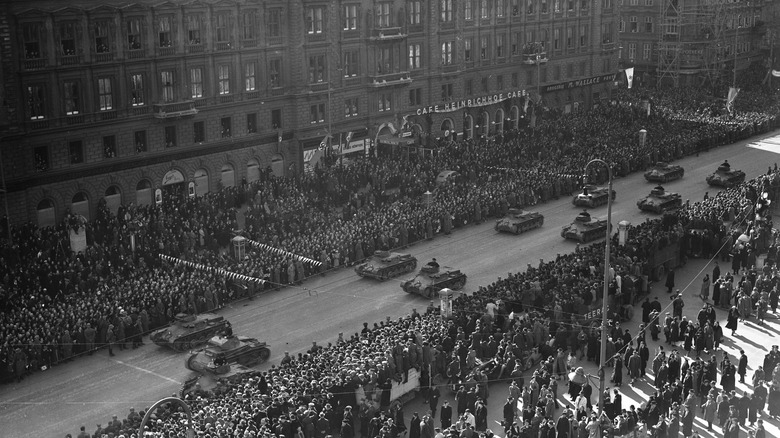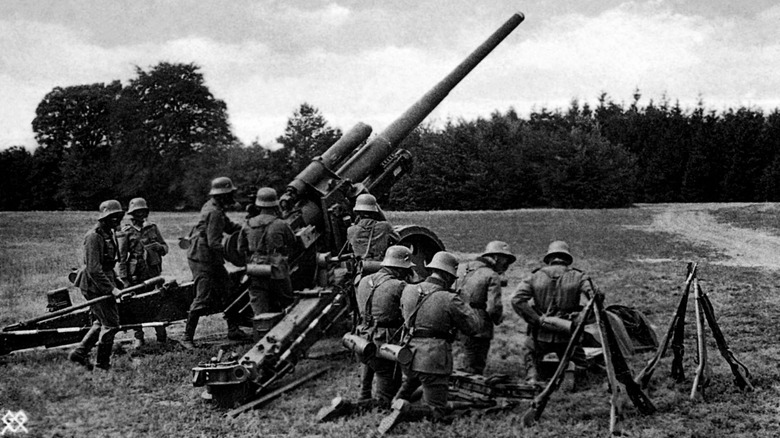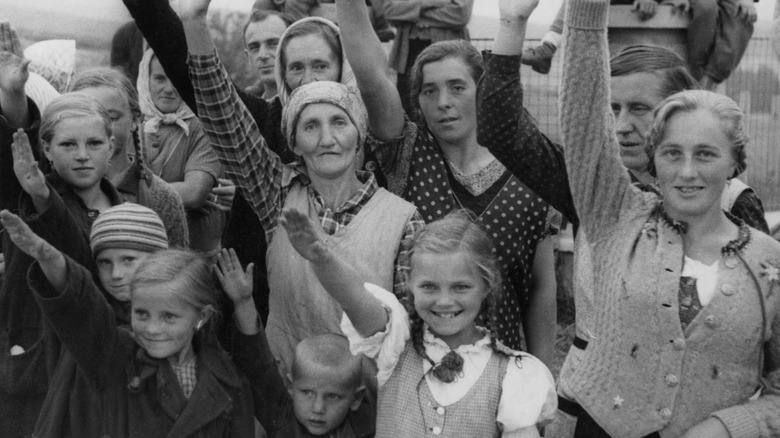How Nazi Propaganda Completely Rewrote The Story Of D-Day
D-Day: A legendary World War II battle where the valiant Nazi protectors of Europe squared off against cruel and oppressive invaders from England, the United States, Russia, and more. Yes, D-Day, where our boys in red and black beat back those dastardly warmongers despite overwhelming odds and a severely underpowered navy. D-Day, the day that clinched victory for Adolf Hitler's Third Reich and began a thousand-year reign of absolute Nazi sovereignty and power.
Yes, it's amazing how Germany's World War II propaganda machine makes D-Day read precisely like a passage from an alternative history book. The tale's false story beats — viewable in full in mini-documentary form on YouTube — portray the type of vainglorious self-image you'd expect from German propaganda master Joseph Goebbels: Nazi Germany is the stalwart, righteous side, and the Allies are the evil interlopers.
Such disinformation was nothing new to the war effort. Goebbels set out to inoculate the German people with every possible inverted truth necessary to convince them of the necessity of their country's war. And so, when faced with defeat on D-Day on June 6, 1944, the Reich Ministry of Public Enlightenment and Propaganda (RMVP) added some more lies to its endless glut of vile, anti-Semitic rhetoric (discussed on the United States Holocaust Memorial Museum) and other propaganda. German newsreels depicted triumphant troops set to brassy music, the roll of mighty German tanks, wrecked Allied vehicles, Allied prisoners in tow, and more.
The war on information
"The essence of propaganda consists in winning people over to an idea so sincerely, so vitally, that in the end they succumb to it utterly and can never again escape from it," wrote the mastermind behind Nazi propaganda, Joseph Goebbels (per PBS). Under Goebbels's guidance, Nazi Germany launched a multiprongged attack of mis- and disinformation on its own citizens through every medium possible: music, films, posters, art, museum exhibits, radio broadcasts, frothing speeches, theater, "news" publications, and even postcards (pictured above) (per Facing History and History Hit). The objective was to wrap the German public in a bubble of false reality. Or as History Hit quotes Hitler himself, "Propaganda tries to force a doctrine on the whole people... Propaganda works on the general public from the standpoint of an idea and makes them ripe for the victory of this idea."
"Victory" is the key term in Hitler's definition. To depict the German war machine as an unstoppable, unbeatable force — and Nazi ideology as superior and worthy of following — what else would the Nazi party do except spin defeat into victory? By the time D-Day rolled around in June, 1944, there were no guarantees that Germany would lose, even though World War II would actually end the following year. As History explains, Germany had marched its way across mainland Europe and made it to Russia in the east and down into northern Africa. D-Day played a significant role in turning the war around.
Twisting defeat into victory
Imperial War Museums describes the Allies' overall strategy on D-Day, and how the assault played out. The goal of D-Day's "Operation Overlord" was to open another front and cut into German-occupied territory from the English channel rather than hit Nazi forces head-on via mainland Europe. The losses of World War I had made English commanders skittish about a direct assault, yet the Allies agreed that "overwhelming material and manpower resources" were necessary if Operation Overlord was to succeed. And so, as the U.S. Department of Defense shows, the Allies poured over 150,000 troops into various beaches along Normandy and pushed inland. In the weeks that followed they made it to the critical road junction at Caen, France, from which further assaults could be staged.
According to German propaganda, though, this isn't how things played out at all. The U.S. Navy's Industrial Incentive Division and the Office of Strategic Service (OSS) translated actual footage from a Nazi-crafted mini-documentary about D-Day intended for German viewers (available on YouTube). The propagandistic strategy on display in the film is simple, though effective. Instead of state the results of D-Day, the film paints a picture of half-truths using little victorious German vignettes: look at how we met the Allies with heavy gunfire, look at how we sprayed the Allies with flamethrowers, look at how we captured Americans and Canadians, look at German tanks rolling forward, etc. But in the end, such messaging proved as futile as the entire Nazi war effort.


